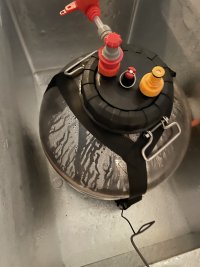terrypratt1
Well-Known Member
I've just brewed my first batch in a new All Rounder, Cold Crashing now, and will be doing my first closed transfer. I am also doing my first cold crash and the combination of the All Rounder, Cold Crash, and transfer leaves me with questions.
The fermenter sits in my chest freezer, and with some pressure in the fermenter I also have condensation on the inside of the fermenter. This makes it pretty much impossible to see the transfer progress (i.e. the floating dip tube and when it gets to the trub). I'm wondering what I should do - do I let it cold crash for 3 days (38 degrees) and then try and lift the fermenter out of the freezer so I can get it onto a surface where I can see how the transfer progresses? Would this work against the cold crashing by stirring everything up - or do I simply let it settle a bit and the cold crash took care of getting most of the yeast and hops out of suspension.
I really can't see how to effectively transfer while in the chest freezer. All the video i've seen on transfers of course either have water or a crystal-clear view into the fermenter - and I don't want to go thru the effort and then have it suck in all the trub or waste too much of my brew.
Any advise on handling a similar situation?
Thanks,
Terry
The fermenter sits in my chest freezer, and with some pressure in the fermenter I also have condensation on the inside of the fermenter. This makes it pretty much impossible to see the transfer progress (i.e. the floating dip tube and when it gets to the trub). I'm wondering what I should do - do I let it cold crash for 3 days (38 degrees) and then try and lift the fermenter out of the freezer so I can get it onto a surface where I can see how the transfer progresses? Would this work against the cold crashing by stirring everything up - or do I simply let it settle a bit and the cold crash took care of getting most of the yeast and hops out of suspension.
I really can't see how to effectively transfer while in the chest freezer. All the video i've seen on transfers of course either have water or a crystal-clear view into the fermenter - and I don't want to go thru the effort and then have it suck in all the trub or waste too much of my brew.
Any advise on handling a similar situation?
Thanks,
Terry



